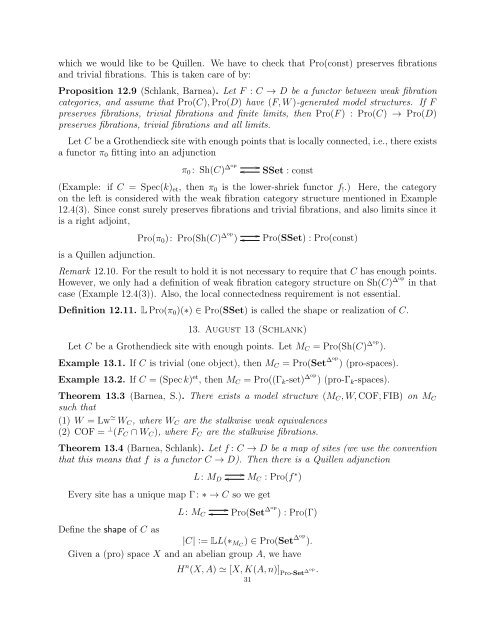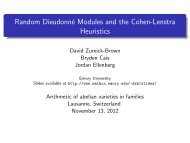alternative lecture notes - Rational points and algebraic cycles
alternative lecture notes - Rational points and algebraic cycles
alternative lecture notes - Rational points and algebraic cycles
You also want an ePaper? Increase the reach of your titles
YUMPU automatically turns print PDFs into web optimized ePapers that Google loves.
which we would like to be Quillen. We have to check that Pro(const) preserves fibrations<br />
<strong>and</strong> trivial fibrations. This is taken care of by:<br />
Proposition 12.9 (Schlank, Barnea). Let F : C → D be a functor between weak fibration<br />
categories, <strong>and</strong> assume that Pro(C), Pro(D) have (F, W )-generated model structures. If F<br />
preserves fibrations, trivial fibrations <strong>and</strong> finite limits, then Pro(F ) : Pro(C) → Pro(D)<br />
preserves fibrations, trivial fibrations <strong>and</strong> all limits.<br />
Let C be a Grothendieck site with enough <strong>points</strong> that is locally connected, i.e., there exists<br />
a functor π 0 fitting into an adjunction<br />
π 0 : Sh(C) ∆op <br />
SSet : const<br />
(Example: if C = Spec(k) et , then π 0 is the lower-shriek functor f ! .) Here, the category<br />
on the left is considered with the weak fibration category structure mentioned in Example<br />
12.4(3). Since const surely preserves fibrations <strong>and</strong> trivial fibrations, <strong>and</strong> also limits since it<br />
is a right adjoint,<br />
is a Quillen adjunction.<br />
Pro(π 0 ): Pro(Sh(C) ∆op )<br />
Pro(SSet) : Pro(const)<br />
Remark 12.10. For the result to hold it is not necessary to require that C has enough <strong>points</strong>.<br />
However, we only had a definition of weak fibration category structure on Sh(C) ∆op in that<br />
case (Example 12.4(3)). Also, the local connectedness requirement is not essential.<br />
Definition 12.11. L Pro(π 0 )(∗) ∈ Pro(SSet) is called the shape or realization of C.<br />
13. August 13 (Schlank)<br />
Let C be a Grothendieck site with enough <strong>points</strong>. Let M C = Pro(Sh(C) ∆op ).<br />
Example 13.1. If C is trivial (one object), then M C = Pro(Set ∆op ) (pro-spaces).<br />
Example 13.2. If C = (Spec k) et , then M C = Pro((Γ k -set) ∆op ) (pro-Γ k -spaces).<br />
Theorem 13.3 (Barnea, S.). There exists a model structure (M C , W, COF, FIB) on M C<br />
such that<br />
(1) W = Lw ≃ W C , where W C are the stalkwise weak equivalences<br />
(2) COF = ⊥ (F C ∩ W C ), where F C are the stalkwise fibrations.<br />
Theorem 13.4 (Barnea, Schlank). Let f : C → D be a map of sites (we use the convention<br />
that this means that f is a functor C → D). Then there is a Quillen adjunction<br />
<br />
L: M D M C : Pro(f ∗ )<br />
Every site has a unique map Γ: ∗ → C so we get<br />
<br />
L: M C Pro(Set ∆op ) : Pro(Γ)<br />
Define the shape of C as<br />
|C| := LL(∗ MC ) ∈ Pro(Set ∆op ).<br />
Given a (pro) space X <strong>and</strong> an abelian group A, we have<br />
H n (X, A) ≃ [X, K(A, n)] Pro-Set ∆ op .<br />
31



